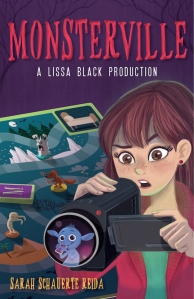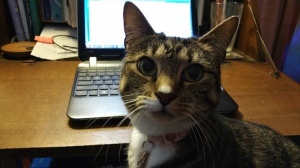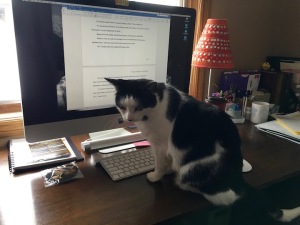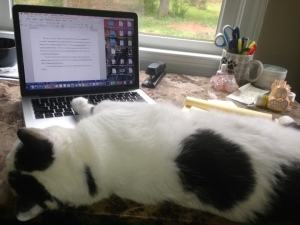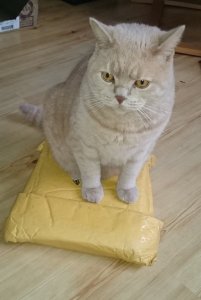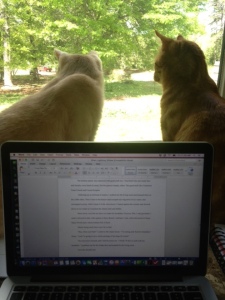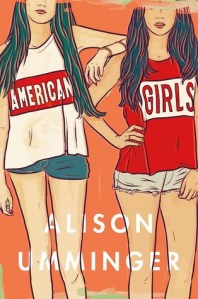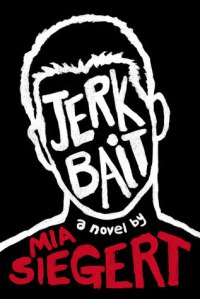I’m writing this particular post for both competitors and spectators of the wonderful Query Kombat contest put on by Michelle Hauck, Michael Anthony and Laura Heffernan each year. I’m a judge this time around, and I’m super excited to be involved!
For those of you unfamiliar with the process, Query Kombat is a bracket style competition where 64 query letters and first pages are matched against each other until only one is left. There are six rounds of competition that last the entire month of June, where the judges leave notes and determine the winners. Agents monitor the contest and make requests based on the queries.
Since we have some time before entries are due (submission is between May 16th and the 21st), I thought it would be fun (and humane) to offer some query tips – five this week, and five next week. No one likes to query (hooray! constant rejection!), but it’s a necessary hurtle toward the end of publication. Without a strong query, this wouldn’t be debuting in September:
Sorry, I had to insert at least a little self-promotion. It too me years to get here! But in seriousness, here are five things I wish I’d known ahead of time:
- Structure is important. Queries follow a certain format. It’s important to follow that format. That way, agents know you’ve done your research and also that you can properly structure a piece of writing. Go to sites like Writer’s Digest and read the articles on the necessary components to include in a query letter. An excellent article, which includes examples of successful query letters, is here.
- Test your query first!!!!! If you think your query is ready to go, measure your success rate. Make sure the font and spelling is perfect, and send it out to ten agents who are not in your top tier. If you get a good hit rate – say, two or three requests out of the ten- you’re ready to go broader. Do not go broader before you do this! If you send your query to fifty agents because you are impatient, and subsequently realize the query isn’t that great, that’s fifty closed doors.
- Read awesome queries first. See what works, especially the hook in the first paragraph. I can’t recommend QueryTracker highly enough, especially for its “success story” section. Every success story is accompanied by the query that landed the agent. (This is under the “query” tab, at “success story interviews”). You can search by agent if there’s a particular one you’re stalking. My favorite query ever is Chris Rylander’s (he signed with Stephen Malk of Writers House), but his is extremely out of the box – that won’t work for everyone.
- Get peer input. This might sound kind of obvious, but you’d be surprised at how many people are afraid to share their queries before they send them directly to agents. Don’t be. Everyone’s been there, and everyone’s written an awful query. In fact, below this post you’ll find the query for my first book every written, as well as the one for my book that got me my second agent and is being published in September of 2016. (It makes me cringe to share the former with the public, but I tell myself that if you’re brave enough to be in Query Kombat, I’m brave enough to copy/paste!).
- Keep track of who you query. I once queried the same agent twice within a week. Oops. Agents get so many emails, they might not remember your name, but they very well might. You don’t want to end up on an “Annoying Persons” list. Also, do not reply to rejections, even if they’re nice rejections.
Good luck in Query Kombat! Stay tuned for my next post on query tips! Also, you can follow me on Twitter or add my debut to your Goodreads list.
The Query That Landed My Agent:
Dear Ms. Galit:
As I understand you represent writers of middle grade works, I hope you may be interested in my novel, LISSA BLACK AND THE MISFIT MONSTER.
Thirteen year-old Lissa is beyond bummed when her parents ship the family off to live in the boonies of Pennsylvania. She can practically hear the banjos playing.
Country life isn’t boring for long. During a walk in her new woods, Lissa’s terrified when a swamp creature crawls from the creek. Not cool with dying, she convinces her neighbor Adam to use his mad Boy Scout skills to rig a trap. They capture a sniffling, shape-shifting little goblin called Monster. Monster’s an escapee from Down Below – the society of creatures beneath the world’s floorboards. A baby, Monster doesn’t know much about Down Below or how he became a monster. When Lissa and Adam help Monster investigate his origins, they’re horrified at what they find. It gets even scarier when Lissa finds a strange board game called Monsterville in her basement. Is it really only a game?
When Lissa’s little sister Haylie is taken on Halloween, Lissa storms Down Below with Adam and Monster. There, Lissa realizes that Monsterville isn’t just a game. It’s a map of Down Below – a cheat sheet of its twists and turns and the monsters that wait around every corner.
Lissa needs to use her Monsterville knowledge and smarts to grab Haylie and get the heck on out of Down Below by daybreak. If she doesn’t, Down Below will have a few more inhabitants.
Complete at 64,000 words, LISSA BLACK AND THE MISFIT MONSTER is GOONIES meets JUMANJI, a fast-paced middle grade urban fantasy with series potential. Please let me know if you’d like to read the novel. Thank you very much.
The Query That Impressed No One:
Dear Ms. Agent-Who-Rightfully-Never-Responded:
I understand that you represent authors of young adult fiction and hope you may be interested in my recently completed novel, The Invisible Kid. Written to appeal to children 10-13, it humorously captures the insecurity that can make being in that age group a misery.
Twelve-year old Mitch Traynor would probably be okay with being ordinary if the rest of his family wasn’t so extraordinary. His antagonistic sister Katie is practically a genius. His mother is a famous author. And Mitch’s father is the beloved coach of the high school football team. After years of feeling invisible in the shadows created by his family’s bright spotlight, Mitch comes to a decision. He figures that since he and his family all share the same genes, perhaps he is extraordinary in a way he just hasn’t discovered. It is only a matter of figuring out how. Mitch begins trying on new roles at random, none of which fit and all of which end in humiliation or frustration. As he stumbles along on his ill-fated journey, it becomes clear to the reader that Mitch’s family members aren’t as extraordinary as he thinks they are, and that he isn’t as ordinary. The question is whether Mitch will see this.
Mitch of The Invisible Kid is a sweet, self-deprecating child with whom young readers will identify, his narration echoing their typical feelings of self-doubt. Mitch’s unconsciously humorous efforts to find his extraordinary side will resonate regardless of social or economic context. And the central role played by his family members subtly conveys the importance of having a strong support system.
I am a young lawyer working in Washington, D.C., and this is my first novel. The manuscript is complete (43,646 words). Thank you very much for your consideration.
Writers tend to have lots of pets. We write, we revise, we adopt a cat, we write some more, we start feeding a hobo kitty, we revise, we coax the hobo kitty in, we write, we take a break to watch YouTube videos of animals, we start thinking about how great dogs are. . .
I don’t know why this is. But the general equation is Writer = Too Many Pets.
As much as we writers love our many pets, and even though they love us back (the dogs do, at least), I want us to understand one thing: they do NOT care about our hopes and dreams. At all. Our ARCs are there to be eaten. Our computer is a heating pad. Our notes are a cat bed. Deleting things is fun. Computer cords are delicious.
And here is the evidence, courtesy of my writing comrades who were kind enough to send a photo for posting:

“Human, stop writing and check out all my toys!”
Ella’s human, Elizabeth Briggs, is a young adult writer whose debut, FUTURE SHOCK, is now available (as of April 1st!) from Aw Teen. Follow Elizabeth on Twitter or add her book to your Goodreads list.
Louis’s owner, Abby Cooper, is a writer of middle grade fiction. Her debut, STICKS AND STONES, will be released by Farrar, Straus and Giroux on July 19, 2016. Follow Abby on Twitter or add her book to your Goodreads list.
Pancake’s owner, Kathy MacMillan, penned a young adult fantasy, SWORD AND VERSE, available now from HarperTeen. Follow Kathy on Twitter or add her book to your Goodreads list.
This fuzzy critter is catered to by Dana Elmendorf, whose debut young adult contemporary novel, SOUTH OF SUNSHINE, is available NOW from Albert Whitman & Co. Follow Dana on Twitter or add her book to your Goodreads list.
Margot Harrison, the owner of this fuzzy creature, is a young adult writer whose debut, THE KILER IN ME, will be released by Disney-Hyperion on July 12, 2016. Follow Margot on Twitter or add her thriller to your Goodreads list.
Huntley’s owner, Kate Pawson Studer, is a freelance editor and author of young adult fiction. She is represented by The Stringer Literary Agency. Follow Kate on Twitter.
Pancakes’s human, Sarah Schauerte Reida, will debut in September of 2016 with MONSTERVILLE: A LISSA BLACK PRODUCTION (Sky Pony). Twitter stalk Sarah here, or add her middle grade novel to your Goodreads list.
Phineas’s owner, Bethany Morrow, will debut with Month9Books in September of 2016. Follow her on Twitter or add her young adult book, THE LAST LIFE OF THE AVRILS, to your Goodreads list.
Claire Fayers, who received her ARCs unharmed, is a writer of middle grade fiction and represented by The Bent Agency. Her debut, THE VOYAGE TO MAGICAL NORTH, will be published by Henry Holt and Co. on July 5, 2016. You can follow Claire on Twitter or add her fantasy to your Goodreads list.
Archer’s owner, Sarah, is the author of this post and is adding more pictures of her own because she has SO MANY pets! Archer is a Pit/Lab rescue who is treated like a child. It is kind of disturbing.
These little monsters are ALSO owned by Sarah, but these two are accidental – Knope came from a foster organization that last followed up on him two years ago; and Howie was rescued just in time from Animal Control.
*Sarah Schauerte is a writer of middle grade books, whose website, http://www.lissablackproductions, tests knowledge of movie trivia and educates on the world of film-making. A huge fan of Halloween, it is only fitting that her debut is MONSTERVILLE: A LISSA BLACK PRODUCTION. Follow her on Twitter here.
MONSTERVILLE is JUMANJI meets GOONIES, a fast-paced adventure where board games come alive and winning your life depends on applying monster movie rules of survival. 12-year-old film-obsessed Lissa discovers a shape-shifting monster in her woods and decides to film the greatest horror movie of all time…until her little sister is kidnapped to the monster homeland of Down Below and she needs her star’s help to rescue her.
As a member of the Sweet Sixteeners (a group of writers who are all debuting in 2016), I had the pleasure of receiving an Advanced Release Copy (ARC) of AMERICAN GIRLS by Alison Umminger via snail mail. I read this book in two sittings, thoroughly enjoying this dark coming-of-age novel as it explored complicated relationships, familial bonds, and the need to fit in (and the consequences of feeling like one doesn’t).
AMERICAN GIRLS features Anna, a fifteen year-old girl who steals her stepmother’s credit card to buy a plane ticket to L.A., home to her half-sister Delia, glamorous celebrities. . . and far away from her divorced parents and their respective mates. While she is brooding and a little whiny at times, I understood Anna and her need for escape; and the catalyst of the trip to Hollywood provides the perfect setting for her to grow up.
Once in Hollywood and living with the gorgeous Delia, Anna is exposed to the celebrity life. It has its glamour, but it is also gritty and lonely, and the novel is genius in gradually exposing it as such. (I don’t want to spoil anything, but a billboard as a framing device as Anna arrives in and leaves L.A. was particularly effective).
Delia’s ex-boyfriend, Roger, lurks along the edges of her life; and Anna has a front row ticket to that dysfunctional relationship. She can’t understand why Delia would sacrifice her new relationship with the lovable and kind Dex, who clearly adores her. As a reader, it’s hard to see Delia’s seemingly perfect life be exposed for what it is, because we like Delia despite her deep flaws.
While tagging along to Roger’s set (where Delia is the star), Roger gives Anna a project – learn about the Manson girls, those girls who wanted to belong so badly that they were willing to participate in something evil. The lessons Anna gleans from her research fascinate her and terrify her, making her lock Delia’s door at night when her sister is away and worry that she sees some of herself in the Manson girls. Like them, all she wants is a place to land.
Umminger’s AMERICAN GIRLS is a beautifully-written, poignant coming-of-age novel that is dark but not too dark, taking us along with Anna as she grows up during one important summer. It has everything – fast pacing, believable characters and a compelling storyline made particularly interesting by the Hollywood backdrop. I hope this book is a smash, because it deserves it – I enjoyed being in Anna’s head and taking the journey with her.
As a note, as I turned the pages of the ARC, I noted that those who read before me (the ARC was exchanged among the Sweet Sixteeners, forwarded like a chain letter to whomever had signed up for it), I noted that many passages had been highlighted or annotated. Clearly, I was not the only one to appreciate the beauty of certain passages and the wisdom of Anna’s observations (and how they evolve over the course of the novel).
Also, and technically unrelated to this review – after reading AMERICAN GIRLS, I looked up Alison (ah, the powers of Internet stalking) and found that she and I live less than an hour apart, and before that, we lived in the same town of Arlington, Virginia. Small world.
This Friday, I received an Advanced Release Copy (ARC) of Mia Siegert’s JERKBAIT, which will be released by Jolly Fish Press on May 3, 2016. I finished it on Saturday morning. This is because JERKBAIT, while extremely dark and violent in many respects, is an incredibly fast read with a compelling story that is hard to put down. It touches on many important subjects, like bullying, LGBT rights and issues, coming-of-age experiences, and family relationships. As I read it, I thought of the wonderful Matthew Quick’s work (SILVER LININGS PLAYBOOK, FORGIVE ME, LEONARD PEACOCK).
JERKBAIT is told from the point of view of Tristan, the twin brother of Robbie. Both boys play hockey, but Robbie is the star; and Tristan has lived in his shadow for the boys’ entire lives. The situation is worsened by their parents, whose absolute first (indeed, only) priority is maximizing Robbie’s chances of being drafted to his father’s choice college team.
Tristan’s resentment of Robbie is passive until Robbie overdoses and their parents force the boys to share a room. Believing that the incident is accidental, Tristan resents the new arrangement. He also resents his parents’ insistence that he “watch” Robbie, especially since he finds himself gravitating away from hockey and toward musical theater. He’s a natural, and if his parents hadn’t been so focused on Robbie and Robbie’s hockey career, Tristan might be on track for Broadway. Now, he must make up for wasted time.
Living with Robbie makes Tristan connect with his brother in a way he never has before. He learns that Robbie isn’t the happy, socially adjusted kid he is on the surface – he is dark, brooding, and emotionally isolated from his peers. Meanwhile, Tristan becomes even less enchanted with hockey and storms off the team. Now, he can finally focus on musical theater.
When another athlete accuses Tristan of being gay and attacks him. Robbie fights back and reveals his own secret to the entire cafeteria that holds witness: “Some straight guys like musicals. And some gay guys play hockey.”
Robbie tries to commit suicide again, and the parents react by refusing Robbie help because of the risk of making him appear to be a liability to hockey teams. Instead, they force Tristan to tail Robbie, to give up his lead in the musical to monitor Robbie during hockey practice, and resolutely refuse to acknowledge the real reasons Robbie hurts. This means that the brothers have to deal with the situation together if Robbie has a chance of surviving. This is a haunting, fast-paced story of two brothers caught in a nightmare, and I found myself turning the pages to make sure they got out alive.
By way of criticism, I will say I had trouble reading certain passages. It had nothing to do with the writing or the plotting – it was because the book deals with some bleak issues. It also features some truly heinous people, including a self-centered theater diva who taunts Robbie for his suicide, clueless parents, and an Internet troller.
While I had some issues with these characters – I had particular trouble believing that parents would be that blind or that Tristan’s theater friend would be that heartless – I suspect that this may be because I didn’t grow up dealing with these kinds of issues or people. The reaction of the characters by and among one another was believable; and the story made me root for Tristan, Robbie, and everything they stand for.
Even better, it caused me to think about what they stand for, and I have no doubt that this book will make many others do the same.
Add JERKBAIT to your Goodreads To Read list by clicking here.
*I am a middle grade writer, and my own debut, MONSTERVILLE: A LISSA BLACK PRODUCTION, is coming from Sky Pony Press in September of 2016. You can add it on Goodreads by clicking here.
One of the most challenging aspects of being a writer is avoiding distractions. When I’m clicking away on my keyboard, I fight a number of them: cats jumping on my desk, the dog farting (well, he wanted pizza), husband whining about not being able to find his keys/wallet/head. Sometimes it’s hard to block everything out and focus on the work.
Because of this, I’ve found two things are absolutely important: 1) to find a sanctuary where I can write without distraction; and 2) to know when I’m distracted because I shouldn’t be writing. Both of these save me a lot of time.
With the first, my sanctuary is simple. It’s on my deck (sans pets), with coffee and music – usually Taylor Swift, Gavin DeGraw, or Sheryl Crow. I also adjust my Word document so I can’t see the word count. (Word count isn’t important; telling the story is). This lets me completely focus on my craft. As soon as I find myself getting distracted – pausing to unnecessarily watch a video on the Internet (Sylvester, the foul-mouthed kitty cat, you are awesome!), texting, etc., I know it’s time to take a break.
With the second, it’s important to know when I’m distracted because I shouldn’t be writing. This is generally when I want to feel productive by churning out pages, but I don’t actually have the inspiration. I plod along, increasing my word count, but it’s not natural writing. It might not be terrible, but it isn’t good enough to keep. Or maybe when I’m done with the manuscript, it’s a “problem” spot I revise more than others. It’s not a good use of time. I should go and do something else, and not open that document again until I feel like writing.
So, cat, the next time you walk across my keyboard, thanks a lot. I know you’re totally doing it for my own good, as you’re considerate like that.
In September of 2016, my debut middle grade novel will be published by Sky Pony Press, a division of Skyhorse Publishing. Monstervillle: A Lissa Black Production, is about a thirteen year-old girl who must use her knowledge of movies (and a jacked-up board game entitled Monsterville, found in the basement of her new, creepy home in the middle of the sticks) to rescue her sister from the monsters’ lair of Down Below.
The first and second iterations of Monsterville didn’t focus so much on the film aspect. It was definitely a part of it, but it wasn’t as infused in the plot line as it is now. Then, however, I came across a film terms glossary on the Internet (bless you, Internet). Also, it occurred to me how very much movies have influenced me – thanks, Dad, for letting me watch Terminator with you before I started kindergarten. I know every movie reference there is, and I am obnoxious to play Scene It with because I. Know. EVERYTHING! (Mrahahaha). I realized that I could take the film aspect of Monsterville much, much further than I already had.
Because the main character in Monsterville is obsessed with movies, I was too, for purposes of creating Lissa’s world and how she viewed it. I re-read Monsterville, searching for more opportunities to include film terms. I bought books that instructed on how to survive a horror movie. I learned about screenplay writing – I reviewed screenplays for structure, and I read the amazing Save the Cat by Blake Snyder (among other books on screenplay writing).
As a note, Save the Cat’s title is based on the tip that you should always have the main character do something at the outset that makes the audience identify with her and invest in her experience. (Although it’s not an example provided in the book, which pre-dated the film, a good example of this is Katniss in The Hunger Games. Although a flawed character in many respects, her early self-sacrifice for her sister makes us want the odds to really be in her favor). Sure, Mr. Snyder’s advice was directed to screenwriters, but it applies equally to writers.
I will always be grateful to Monsterville, because, among other rewards, it taught me the value of research. With prior projects, I did my work – reading Soccer for Dummies when a character played soccer, studying dialect and cultural elements, etc., but I never completely immersed myself in a research topic the way I did for Monsterville. The book is certainly better for it – the film aspect is a reason it sold.
And hey! Now I have justification for the number of times I’ve seen Beetlejuice and A Fish Called Wanda. Research!
#SixteenBlogAbout
I am thrilled to announce that Monsterville: A Lissa Black Production will be published by Sky Pony Press, the children’s book imprint of Skyhorse Publishing, Inc. in September of 2016! I’ve known for quite awhile, but I’ve failed to post the story because: 1) I was busy lawyering (my day job); and 2) it needed to truly sink in.
Monsterville is not my first book. It is not even my first or second book that has been on submission to publishers. People hear the stories of Veronica Roth and Stephenie Meyer (who had success right out the gate); and because of those stories, don’t realize that there are hundreds of writers out there who didn’t sell their work right away. Even worse, some writers get agents and never sell at all. It is heartbreaking for us, because our work is personal. Yes, we want it to turn into a commodity, but we tell stories that matter to us. For a story to ultimately get shelved, sucks – to use a literary term.
After I graduated law school, I started taking writing seriously. I joined Query Tracker (which is amazing – every writer should), joined critique groups, swapped with others, etc. I wrote three full books before landing my first agent; and we parted ways two years later. I started querying (sending a book out to agents) in late October of 2014, and my agent, Lauren Galit of the LKG Agency, was the first to offer in early January. After I signed with her, we went on sub in early April and sold in June to the lovely Alison Wiess (who is from Sleepy Hollow – how perfect is that?) of Sky Pony. I admit it – when I saw my listings in Publishers Weekly and Publishers Marketplace last week, I started cracking up. All in all, it took six years.
And I never gave up. It’s not a work ethic thing, although I have plenty of that. I simply wanted it so badly. There’s also the matter of having already invested so much time, but it was the wanting it that kept me going.
Regarding Monsterville itself, it was only a matter of time before I wrote a book like it. I love Halloween, and I love movies. To the former, I grew up in a rural area (very much like Lissa of Monsterville’s Freeburg, Pennsylvania), and we decorated our house for Halloween despite the absence of trick-or-treaters. Family members own a pumpkin farm, Pumpkin Blossom Hill (I designed the website!), and my cousin Jeff specialized in bloody moving hands and fake graves with funny epitaphs. My mother spent hours on my Halloween costume. And – this is huge – my wedding was on Halloween and Halloween-themed. Every table had a different theme – zombie, Pennywise (from King’s It), ghost, haunted forest, etc. The wedding itself was traditional; we effectively just had a rockin’ Halloween party after it.
To the inspiration of movies, my best memories of childhood is camping with my family and watching movies on a T.V. my dad and his best friend hooked up to an R.V. They let me watch anything – my favorite movie is A Fish Called Wanda, and has been since I was about seven. I saw Terminator when I was five years old, against the backdrop of an Illinois campground, along with many other violent, sexually-charged movies that were in retrospect highly inappropriate. (Whatever – I turned out fine). They did, however, transform me into a movie lover, and my husband and I are very proud of our movie room in our new house. (Our movie posters – Wanda, Ghostbusters, Harry Potter, Rocky, Terminator, Indiana Jones, Star Wars).
MONSTERVILLE is in stores in September ’16 and who knows where it will go? I see Lissa’s story as consisting of three books, and I have a vision for them already. Also, I know that I love my writing, and to write, and I will do everything to make it a success. And I am looking forward to a long relationship with my lovely agent, Lauren Gailt!
While re-watching an episode of 30 ROCK for the fifth or sixth time, I witnessedJack Donaghy say to Liz Lemon, “no one really knows what satire is.”
What wise words these are. I had to wonder, how true are they? We’ve heard the word and of works being a satire of something, but how many folks actually understand the difference between that and an adaptation?
A satire makes fun of a something (politics, ideas, theories, etc), while an adaptation is based on a prior work. For example, GULLIVER’S TRAVELS by Jonathan Swift (love it), makes fun of party politics in England. Political cartoons might target a particular candidate or party view (see below).
An adaptation, in contrast, is based on another work. I recently read THE BEGINNING OF EVERYTHING, which is a fun take on THE GREAT GATSBY. BRIDGET JONES, which I have read approximately 413 times, is a loose adaptation of PRIDE AND PREJUDICE. (Why did Helen Fielding kill off Mark Darcy in the sequel? Why? I demand answers!). CLUELESS is a valley girl interpretation of EMMA. Neil Gaiman’s THE GRAVEYARD BOOK is based on THE JUNGLE BOOK.
I’m glad Jack Donagy raised this issue in 30 ROCK, because quite honestly, I haven’t thought about the distinction in years; and as a writer, you need to constantly educate yourself. I will never forget getting a rejection on a query I sent to an agent back in the day, when I first started looking for representation, and s/he kindly pointed out that I shouldn’t be calling my book a “fiction novel.” Oops.
The distinction is also particularly important to me because of my new project, which is loosely based on Stephen King’s NEEDFUL THINGS. It is not a satire, it is an adaptation; and I confirmed this to be sure I was referring to it properly.
I maintain that was a smart move. Because after all, in the words of Jack Donagy, “no one really knows what satire is.”
Below: An example of what satire really is, from Belleville, Illinois-area cartoonist Glenn McCoy:
Writers hate hearing about voice. For many of us, the mention of voice comes simultaneous with a “no.”
“Thank you for thinking of me, but in the end, I didn’t connect with the voice in the way I would need to in order to take this on.”
Does this phrase sound familiar? Writers hear it all too often from agents and editors – if an agent or editor doesn’t love the voice, it’s a deal breaker.
When it comes to voice, there are a number of tips to keep in mind. Although voice is perhaps the most subjective element of a project (It’s like warming to a person – you might love their quirky sense of humor, but another person might hate it), there is such a thing as an objectively “bad” voice.
To make sure your book’s voice is strong, ask yourself these three questions:
First, when you’re writing, can you hear your main character’s voice in your head? You should. (Well, in this instance. Generally speaking, hearing voices in head = bad). You should know if your character will curse, if they’ll say “ain’t” instead of “isn’t,” if they’ll talk a mile a minute in an awkward social setting or clam up, if they’re the type to say “um.” If you don’t know that, it will give your reader pause.
Second, does the voice match the character? If you’re writing Boy, the character needs to sound like a boy. If you’re writing Girl, same thing. Read other successful books featuring characters similar to yours (age, background, demographic, etc.), and see how the voice is done.
Third, does your voice connect with a reader? Keeping in mind that voice is subjective (which is why ten publishing houses will pass and one will make a writer as happy as Eddie Redmayne winning his Oscar), be aware that your main character should connect. And when I say “connect,” I don’t mean “be likable.” For example, look at Patrick in Bret Easton Ellis’ AMERICAN PSYCHO. He’s a sociopath, and somehow it is fun to listen to him (especially while he is pontificating on the merits of Huey Lewis and the News while murdering someone). Along with the hook, the voice is what draws the reader in. They start the first few pages of a novel, and decide whether they want the conversation to continue. (One of the best voices I’ve read in recent months is Ezra in Robyn Schneiders’ THE BEGINNING OF EVERYTHING, a contemporary young adult novel loosely based on THE GREAT GATSBY).
If you can answer all three of these questions affirmatively, and honestly, you have your voice. If agents and/or editors don’t like it, know that voice is subjective and you simply may not have found the right home for your work yet. And here’s to hoping that you do soon!
*This article is one of a three-part series written for C1Blitz 15, a competition hosted by Freshly Squeezed Reads which will be part of the Digital Writers Festival 2015. I was thrilled to play a role as an Industry Pro judge and featured blogger!
A few weeks ago, I blogged on the first rule in writing a killer first chapter, which is preparation. Namely, don’t worry about making a first chapter perfect straight out the gate – get your story down, understand what your book is about, and take another look at the first chapter before sending it to Query Land. The first chapter will/should always be rough because you wrote it first, which is why you should look at it last, as well.
So what’s the next rule in writing a killer first chapter? Are you ready for it? Here we go…
Start where the story begins.
Well, thanks a lot, you’re thinking to yourself. I totally could not have thought of that on my own.
I know, I know, this seem obvious, but it’s hard to get right. In your mind (and probably on paper), you have an outline of your story. You’ve mapped out the major conflict, the subplots, and the characters; and while as a good writer, you know that your imagination might make you stray from your path if it feels right, you know your destination.
With so much information in your head, it might be hard to figure out where to begin. You want the reader to understand your character, so you might be inclined to bog down the beginning with well-written (but unnecessary) backstory. You might worry that you need a lot of action right away, so the result is an action-packed start that endangers characters before the reader is invested in them.
To start where the story begins, think of where you’re headed. The beginning should be the action that introduces the stakes. For example, while house-sitting for my parents last week, I read three books: THE STAND, TWILIGHT (I know, I know, but those books are entertaining), and ELEANOR & PARK. Consider where these three books begin, based on where they end up:
- In THE STAND (which is possibly the greatest novel ever written), the book begins when an Army official escapes from his post after a weaponized strain of influenza (Captain Trips) is accidentally released. That Army official goes on to infect others, and Captain Trips ultimately wipes out about 99% of society. The book is about what happens post-Armageddon and who will prevail in a stand between the remaining good folks versus the remaining evil folks. The beginning to this novel is perfect, as the story begins when Captain Trips begins its trail of destruction.
- In TWILIGHT, the book begins when Bella moves to Forks. After setting the scene, Stephanie Meyer almost immediately introduces the love interest, Edward. Right away, the reader has a sense of Bella, the gloomy surroundings of the small Washington town (a perfect habitat for vampires), and feels the connection between the unconventional couple.
- In ELEANOR & PARK, the book begins when Park meets Eleanor on the bus. The story is a love story. It begins when the characters meet. Simple. (In fact, everything about that book is simple and utilitarian. It is almost all dialogue, and its stripped-down nature enhances the power of the story).
If you’re having trouble figuring out where your story begins, don’t feel bad. We’ve all been there. Heck, I was there recently. In my new advanced middle grade book, LISSA BLACK PRESENTS: MONSTERVILLE, I rewrote the beginning about five times.
In my book, the story begins where my main character (Lissa) moves to dinky little Freeburg and finds a monster skulking in the woods behind her creek. In the first iteration, Lissa’s still in her old town, upset about the move. In the second iteration, Lissa’s en route to Freeburg. And in the third iteration, she’s looking around her new house and thinking, What a dump. That is where the story begins. And sure, it was annoying to kill my darlings by hacking away at my first chapter, but that’s what you have to do sometimes.
Good luck! And don’t miss out on the third and final installment of this blog series. If you follow me on Twitter, I’ll post the blog when it becomes available.

